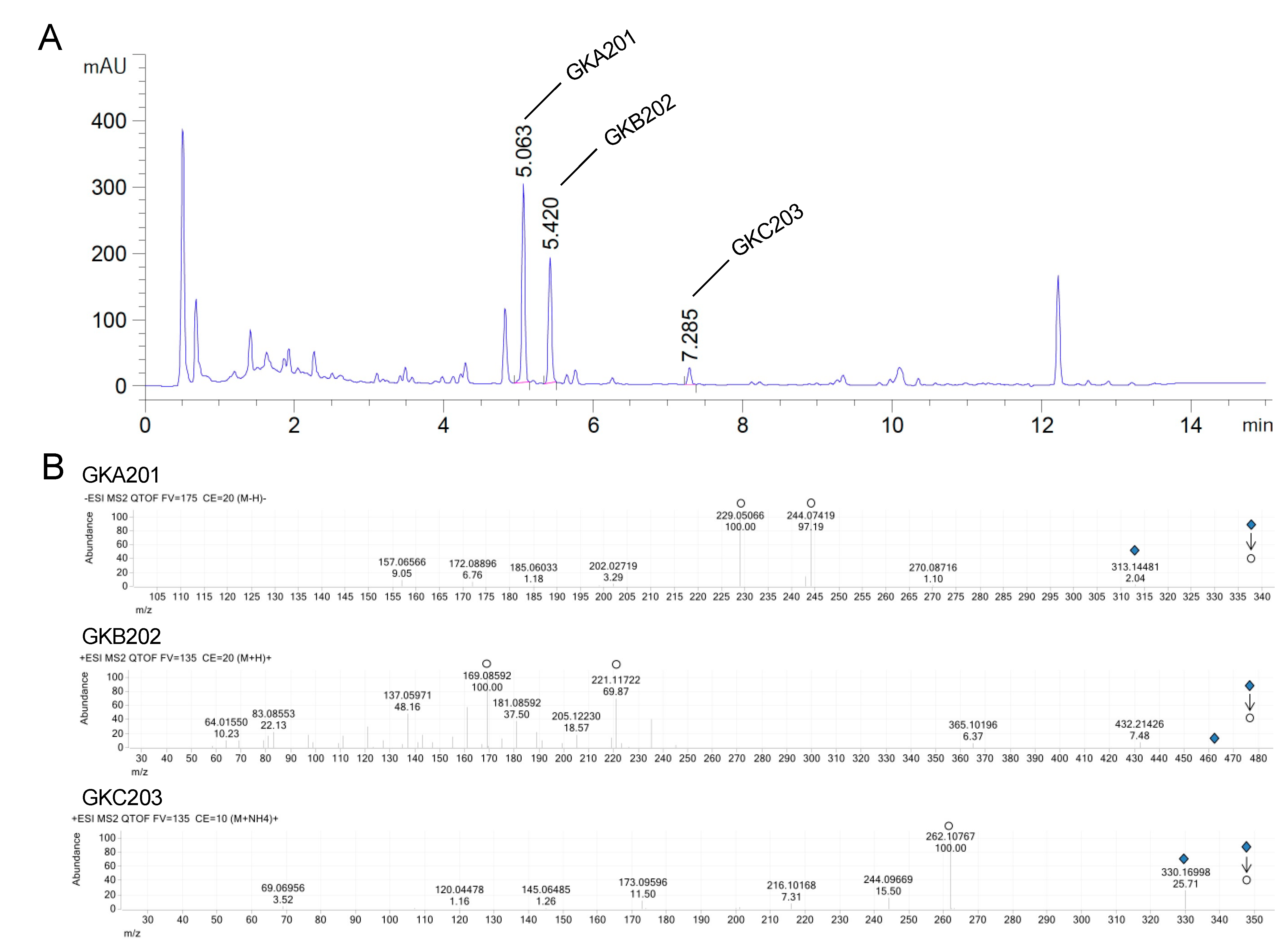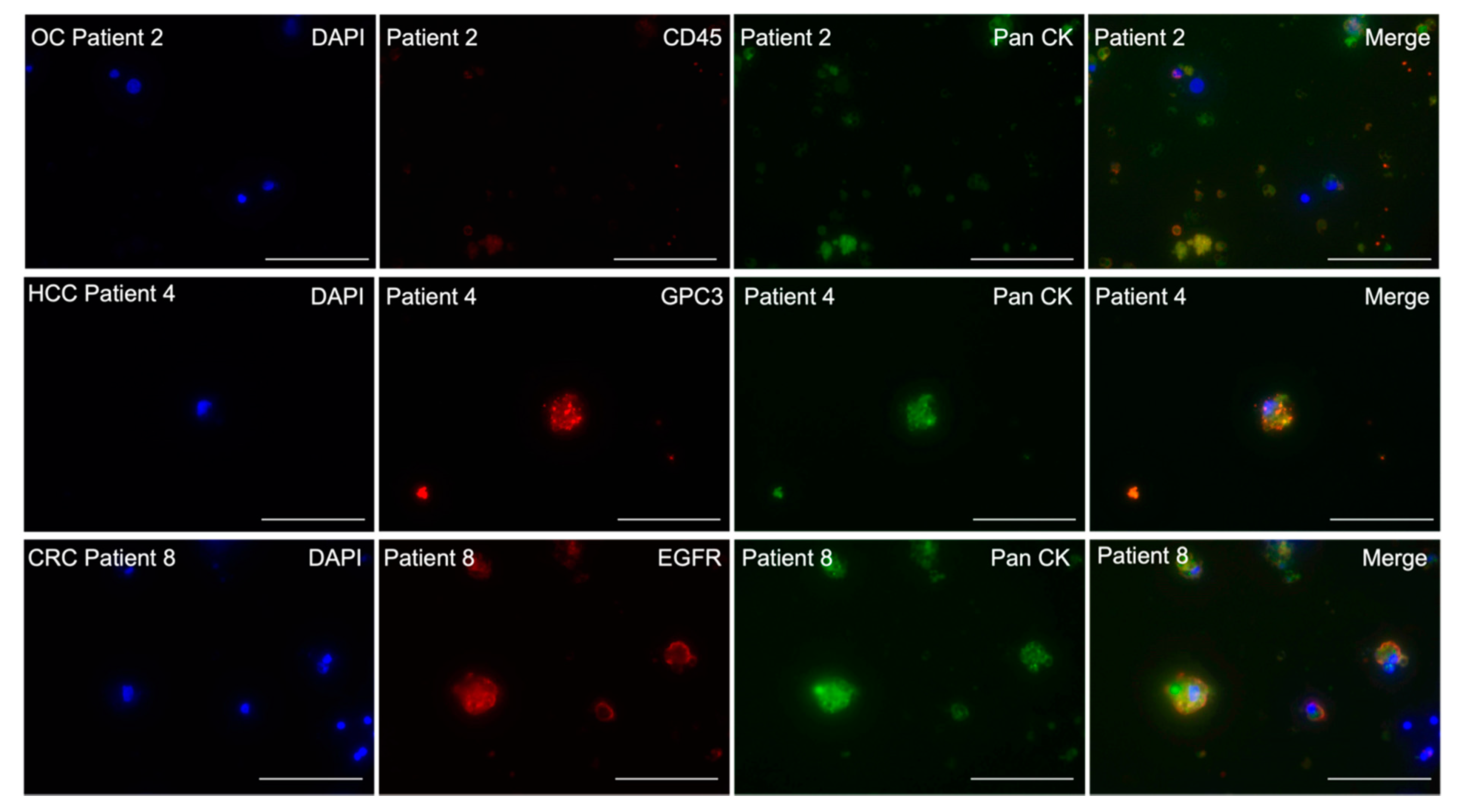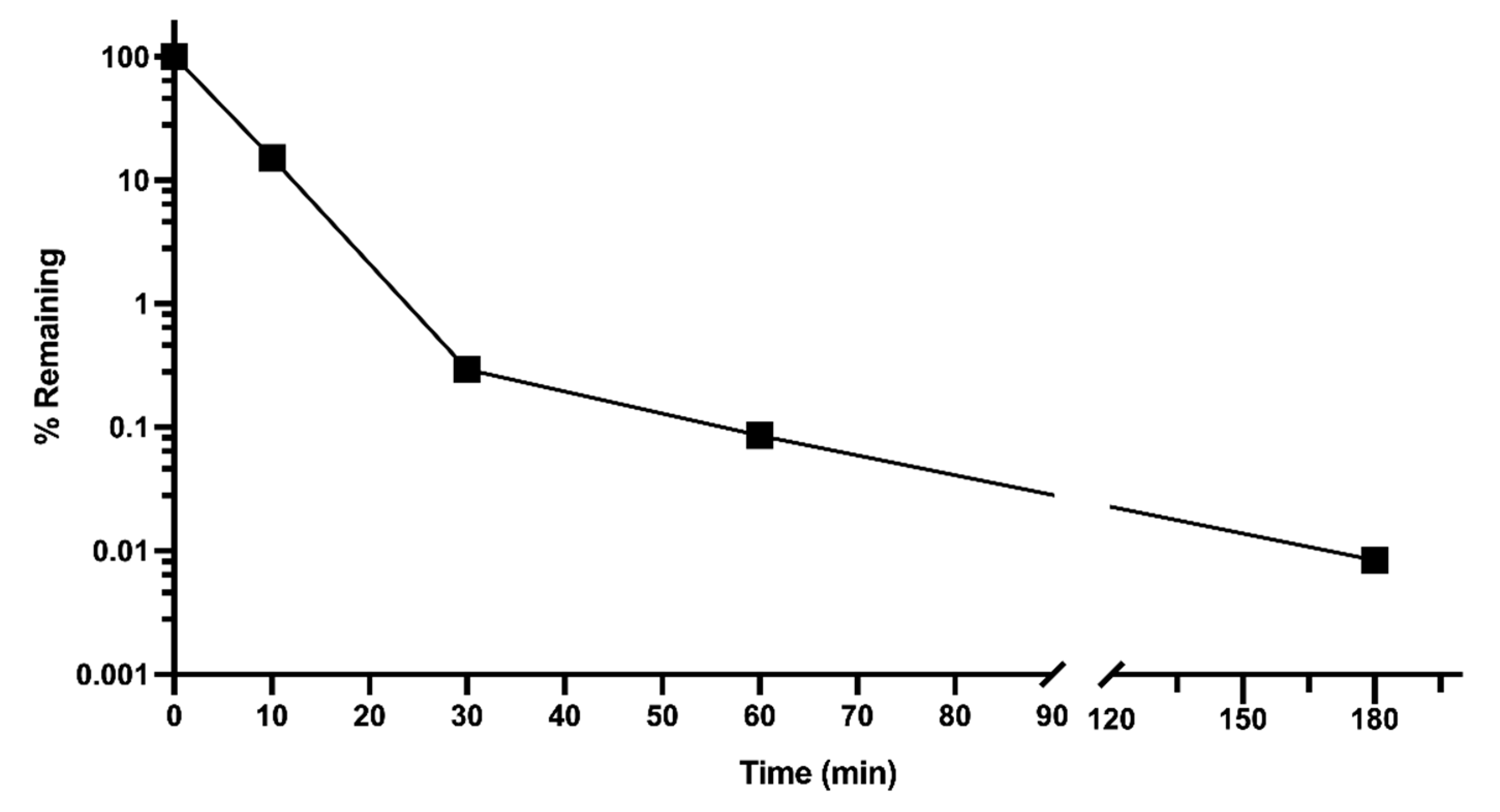Patient-Derived Tumor Chemosensitization of GKB202, an Antrodia Cinnamomea Mycelium-Derived Bioactive Compound
Abstract
:1. Introduction
2. Materials and Methods
2.1. Preparation of the Purified Compounds from A Specific Batch of ACM
2.2. Patients and CTC Expansion
2.3. Viability Assay and the Screening of Anti-Tumor Activity of ACM-Derived Compounds
2.4. Viability Assay and the Screening of Anti-Tumor Activity of GKB202 Compound
2.5. Bioactivation Analysis of GKB202 in Rat Liver S9
2.6. Quantification of GKB202 Metabolic Stability in Rat Liver S9
2.7. Statistical Analysis
3. Results
3.1. Fingerprint Chromatogram of Pure Compounds from the Powder of ACM
3.2. Establishing Patient Derived Circulating Tumor Cells Profile
3.3. Effect of GKA201, GKB202 and GKC203 on Patient-Derived Circulating Tumor Cells Survival Rate
3.4. In Vivo Observation of GKB202 in Sprague-Dawley Rat Analysis
3.5. Metabolic Stability of GKB202 in Rat Liver S9 Analysis
4. Discussion
5. Conclusions
Supplementary Materials
Author Contributions
Funding
Institutional Review Board Statement
Informed Consent Statement
Data Availability Statement
Conflicts of Interest
Sample Availability
References
- Lu, M.-C.; El-Shazly, M.; Wu, T.-Y.; Du, Y.-C.; Chang, T.-T.; Chen, C.-F.; Hsu, Y.-M.; Lai, K.-H.; Chiu, C.-P.; Chang, F.-R.; et al. Recent Research and Development of Antrodia Cinnamomea. Pharmacol. Ther. 2013, 139, 124–156. [Google Scholar] [CrossRef]
- Zhang, B.-B.; Hu, P.-F.; Huang, J.; Hu, Y.-D.; Chen, L.; Xu, G.-R. Current Advances on the Structure, Bioactivity, Synthesis, and Metabolic Regulation of Novel Ubiquinone Derivatives in the Edible and Medicinal Mushroom Antrodia Cinnamomea. J. Agric. Food Chem. 2017, 65, 10395–10405. [Google Scholar] [CrossRef]
- Tsai, T.-C.; Tung, Y.-T.; Kuo, Y.-H.; Liao, J.-W.; Tsai, H.-C.; Chong, K.-Y.; Chen, H.-L.; Chen, C.-M. Anti-Inflammatory Effects of Antrodia Camphorata, a Herbal Medicine, in a Mouse Skin Ischemia Model. J. Ethnopharmacol. 2015, 159, 113–121. [Google Scholar] [CrossRef]
- Chang, C.-J.; Lu, C.-C.; Lin, C.-S.; Martel, J.; Ko, Y.-F.; Ojcius, D.M.; Wu, T.-R.; Tsai, Y.-H.; Yeh, T.-S.; Lu, J.-J.; et al. Antrodia Cinnamomea Reduces Obesity and Modulates the Gut Microbiota in High-Fat Diet-Fed Mice. Int. J. Obes. 2018, 42, 231–243. [Google Scholar] [CrossRef] [Green Version]
- Lin, Y.-S.; Lin, Y.-Y.; Yang, Y.-H.; Lin, C.-L.; Kuan, F.-C.; Lu, C.-N.; Chang, G.-H.; Tsai, M.-S.; Hsu, C.-M.; Yeh, R.-A.; et al. Antrodia Cinnamomea Extract Inhibits the Proliferation of Tamoxifen-Resistant Breast Cancer Cells through Apoptosis and skp2/microRNAs Pathway. BMC Complement. Altern. Med. 2018, 18, 1–11. [Google Scholar] [CrossRef] [PubMed] [Green Version]
- Chen, C.-C.; Li, I.-C.; Lin, T.-W.; Chang, H.-L.; Lin, W.H.; Shen, Y.-C. Efficacy and Safety of Oral Antrodia Cinnamomea Mycelium in Mildly Hypertensive Adults: A Randomized Controlled Pilot Clinical Study. Eur. J. Integr. Med. 2016, 8, 654–660. [Google Scholar] [CrossRef]
- Yen, I.-C.; Tu, Q.-W.; Chang, T.-C.; Lin, P.-H.; Li, Y.-F.; Lee, S.-Y. 4-Acetylantroquinonol B Ameliorates Nonalcoholic Steatohepatitis by Suppression of ER Stress and NLRP3 Inflammasome Activation. Biomed. Pharmacother. 2021, 138, 111504. [Google Scholar] [CrossRef] [PubMed]
- Chiou, Y.-L.; Chyau, C.-C.; Li, T.-J.; Kuo, C.-F.; Kang, Y.-Y.; Chen, C.-C.; Ko, W.-S. Hepatoprotective Effect of Antrodia Cinnamomea Mycelium in Patients with Nonalcoholic Steatohepatitis: A Randomized, Double-Blind, Placebo-Controlled Trial. J. Am. Coll. Nutr. 2021, 40, 349–357. [Google Scholar] [CrossRef] [PubMed]
- Huang, T.-T.; Lan, Y.-W.; Chen, C.-M.; Ko, Y.-F.; Ojcius, D.M.; Martel, J.; Young, J.D.; Chong, K.-Y. Antrodia Cinnamomea Induces Anti-Tumor Activity by Inhibiting the STAT3 Signaling Pathway in Lung Cancer Cells. Sci. Rep. 2019, 9, 1–11. [Google Scholar] [CrossRef] [PubMed] [Green Version]
- Liu, Y.-M.; Liu, Y.-K.; Lan, K.-L.; Lee, Y.-W.; Tsai, T.-H.; Chen, Y.-J. Medicinal Fungus Antrodia Cinnamomea Inhibits Growth and Cancer Stem Cell Characteristics of Hepatocellular Carcinoma. Evid. Based. Complement. Alternat. Med. 2013, 2013, 569737. [Google Scholar]
- Chen, Y.-C.; Liu, Y.-C.; El-Shazly, M.; Wu, T.-Y.; Chang, J.-G.; Wu, Y.-C. Antrodia Cinnamomea, a Treasured Medicinal Mushroom, Induces Growth Arrest in Breast Cancer Cells, T47D Cells: New Mechanisms Emerge. Int. J. Mol. Sci. 2019, 20, 833. [Google Scholar] [CrossRef] [Green Version]
- Chang, C.-W.; Chen, C.-C.; Wu, M.-J.; Chen, Y.-S.; Chen, C.-C.; Sheu, S.-J.; Lin, T.-W.; Chou, S.-H.; Lin, S.-C.; Liu, C.-J.; et al. Active Component of Antrodia Cinnamomea Mycelia Targeting Head and Neck Cancer Initiating Cells through Exaggerated Autophagic Cell Death. Evid. Based. Complement. Alternat. Med. 2013, 2013, 1–15. [Google Scholar] [CrossRef] [Green Version]
- Su, Y.; Shih, P.-H.; Lee, W.-H.; Bamodu, O.A.; Wu, A.T.H.; Huang, C.-C.; Zeng, Y.-M.; Hsiao, M.; Yeh, C.-T.; Lin, C.-M. Antrodia Cinnamomea Sensitizes Radio-/chemo-Therapy of Cancer Stem-like Cells by Modulating microRNA Expression. J. Ethnopharmacol. 2017, 207, 47–56. [Google Scholar] [CrossRef]
- Huang, Y.-J.; Yadav, V.K.; Srivastava, P.; Wu, A.T.H.; Huynh, T.-T.; Wei, P.-L.; Huang, C.-Y.F.; Huang, T.-H. Antrodia Cinnamomea Enhances Chemo-Sensitivity of 5-FU and Suppresses Colon Tumorigenesis and Cancer Stemness via Up-Regulation of Tumor Suppressor miR-142-3p. Biomolecules 2019, 9, 306. [Google Scholar] [CrossRef] [Green Version]
- Lin, T.-J.; Lai, K.-C.; Lee, A.-S.; Chang, C.-H.; Liu, C.-L.; Chung, C.-H. Novel Antrodia Cinnamomea Extract Reduced Cancer Stem-Like Phenotype Changes and Resensitized KRAS-Mutant Colorectal Cancer via a MicroRNA-27a Pathway. Cancers 2019, 11, 1657. [Google Scholar] [CrossRef] [Green Version]
- Caras, I.W. Two Cancer Stem Cell-targeted Therapies in Clinical Trials as Viewed from the Standpoint of the Cancer Stem Cell Model. STEM CELLS Transl. Med. 2020, 9, 821–826. [Google Scholar] [CrossRef] [Green Version]
- Vlachogiannis, G.; Hedayat, S.; Vatsiou, A.; Jamin, Y.; Fernández-Mateos, J.; Khan, K.; Lampis, A.; Eason, K.; Huntingford, I.; Burke, R.; et al. Patient-Derived Organoids Model Treatment Response of Metastatic Gastrointestinal Cancers. Science 2018, 359, 920–926. [Google Scholar] [CrossRef] [Green Version]
- Hou, J.-M.; Krebs, M.G.; Lancashire, L.; Sloane, R.; Backen, A.; Swain, R.-K.; Priest, L.J.C.; Greystoke, A.; Zhou, C.; Morris, K.; et al. Clinical Significance and Molecular Characteristics of Circulating Tumor Cells and Circulating Tumor Microemboli in Patients With Small-Cell Lung Cancer. J. Clin. Oncol. 2012, 30, 525–532. [Google Scholar] [CrossRef] [PubMed]
- Gkountela, S.; Castro-Giner, F.; Szczerba, B.M.; Vetter, M.; Landin, J.; Scherrer, R.; Krol, I.; Scheidmann, M.C.; Beisel, C.; Stirnimann, C.U.; et al. Circulating Tumor Cell Clustering Shapes DNA Methylation to Enable Metastasis Seeding. Cell 2019, 176, 98–112. [Google Scholar] [CrossRef] [PubMed] [Green Version]
- Papadaki, M.A.; Stoupis, G.; Theodoropoulos, P.A.; Mavroudis, D.; Georgoulias, V.; Agelaki, S. Circulating Tumor Cells with Stemness and Epithelial-to-Mesenchymal Transition Features Are Chemoresistant and Predictive of Poor Outcome in Metastatic Breast Cancer. Mol. Cancer Ther. 2019, 18, 437–447. [Google Scholar] [CrossRef] [PubMed] [Green Version]
- Lee, H.-L.; Chiou, J.-F.; Wang, P.-Y.; Lu, L.-S.; Shen, C.-N.; Hsu, H.-L.; Burnouf, T.; Ting, L.-L.; Chou, P.-C.; Chung, C.-L.; et al. Ex Vivo Expansion and Drug Sensitivity Profiling of Circulating Tumor Cells from Patients with Small Cell Lung Cancer. Cancers 2020, 12, 3394. [Google Scholar] [CrossRef] [PubMed]
- Nakamura, N.; Hirakawa, A.; Gao, J.-J.; Kakuda, H.; Shiro, M.; Komatsu, Y.; Sheu, C.-C.; Hattori, M. Five New Maleic and Succinic Acid Derivatives from the Mycelium of Antrodia camphorate and Their Cytotoxic Effects on LLC Tumor Cell Line. J. Nat. Prod. 2004, 67, 46–48. [Google Scholar] [CrossRef] [PubMed]
- Enkhbat, M.; Liu, Y.-C.; Kim, J.; Xu, Y.; Yin, Z.; Liu, T.-M.; Deng, C.-X.; Zou, C.; Xie, X.; Li, X. and Wang, P.-Y. Expansion of Rare Cancer Cells into Tumoroids for Therapeutic Regimen and Cancer Therapy. Adv. Therap. 2021, 4, 17. [Google Scholar] [CrossRef]
- Cristofanilli, M.; Budd, G.T.; Ellis, M.J.; Stopeck, A.; Matera, J.; Miller, M.C.; Reuben, J.M.; Doyle, G.V.; Allard, W.J.; Terstappen, L.W.M.M.; et al. Circulating Tumor Cells, Disease Progression, and Survival in Metastatic Breast Cancer. N. Engl. J. Med. 2004, 351, 781–791. [Google Scholar] [CrossRef] [PubMed] [Green Version]
- Namekawa, T.; Ikeda, K.; Horie-Inoue, K.; Inoue, S. Application of Prostate Cancer Models for Preclinical Study: Advantages and Limitations of Cell Lines, Patient-Derived Xenografts, and Three-Dimensional Culture of Patient-Derived Cells. Cells 2019, 8, 74. [Google Scholar] [CrossRef] [PubMed] [Green Version]
- Puca, L.; Bareja, R.; Prandi, D.; Shaw, R.; Benelli, M.; Karthaus, W.R.; Hess, J.; Sigouros, M.; Donoghue, A.; Kossai, M.; et al. Patient Derived Organoids to Model Rare Prostate Cancer Phenotypes. Nat. Commun. 2018, 9, 1–10. [Google Scholar] [CrossRef] [PubMed] [Green Version]
- Schehr, J.L.; Schultz, Z.D.; Warrick, J.W.; Guckenberger, D.J.; Pezzi, H.M.; Sperger, J.M.; Heninger, E.; Saeed, A.; Leal, T.; Mattox, K.; et al. High Specificity in Circulating Tumor Cell Identification Is Required for Accurate Evaluation of Programmed Death-Ligand 1. PLoS ONE 2016, 11, e0159397. [Google Scholar] [CrossRef] [Green Version]
- Yu, M.; Bardia, A.; Aceto, N.; Bersani, F.; Madden, M.W.; Donaldson, M.C.; Desai, R.; Zhu, H.; Comaills, V.; Zheng, Z.; et al. Cancer Therapy. Ex Vivo Culture of Circulating Breast Tumor Cells for Individualized Testing of Drug Susceptibility. Science 2014, 345, 216–220. [Google Scholar] [CrossRef] [Green Version]
- Hsu, Y.-L.; Kuo, Y.-C.; Kuo, P.-L.; Ng, L.-T.; Kuo, Y.-H.; Lin, C.-C. Apoptotic Effects of Extract from Antrodia Camphorata Fruiting Bodies in Human Hepatocellular Carcinoma Cell Lines. Cancer Lett. 2005, 221, 77–89. [Google Scholar] [CrossRef]
- Hsu, Y.-L.; Kuo, P.-L.; Cho, C.-Y.; Ni, W.-C.; Tzeng, T.-F.; Ng, L.-T.; Kuo, Y.-H.; Lin, C.-C. Antrodia Cinnamomea Fruiting Bodies Extract Suppresses the Invasive Potential of Human Liver Cancer Cell Line PLC/PRF/5 through Inhibition of Nuclear Factor kappaB Pathway. Food Chem. Toxicol. 2007, 45, 1249–1257. [Google Scholar] [CrossRef]
- Lu, M.-C.; Du, Y.-C.; Chuu, J.-J.; Hwang, S.-L.; Hsieh, P.-C.; Hung, C.-S.; Chang, F.-R.; Wu, Y.-C. Active Extracts of Wild Fruiting Bodies of Antrodia Camphorata (EEAC) Induce Leukemia HL 60 Cells Apoptosis Partially through Histone Hypoacetylation and Synergistically Promote Anticancer Effect of Trichostatin A. Arch. Toxicol. 2009, 83, 121–129. [Google Scholar] [CrossRef]
- Hseu, Y.-C.; Yang, H.-L.; Lai, Y.-C.; Lin, J.-G.; Chen, G.-W.; Chang, Y.-H. Induction of Apoptosis by Antrodia Camphorata in Human Premyelocytic Leukemia HL-60 Cells. Nutr. Cancer 2004, 48, 189–197. [Google Scholar] [CrossRef]
- Chang, C.-W.; Chen, Y.-S.; Chen, C.-C.; Chan, I.-O.; Chen, C.-C.; Sheu, S.-J.; Lin, T.-W.; Chou, S.-H.; Liu, C.-J.; Lee, T.-C.; et al. Targeting Cancer Initiating Cells by Promoting Cell Differentiation and Restoring Chemosensitivity via Dual Inactivation of STAT3 and Src Activity Using an Active Component of Antrodia Cinnamomea Mycelia. Oncotarget 2016, 7, 73016–73031. [Google Scholar] [CrossRef] [Green Version]
- Long, H.; Hu, C.-T.; Weng, C.-F. Prolongs Survival in a Patient with Small Cell Lung Cancer. Medicina 2019, 55, 640. [Google Scholar] [CrossRef] [Green Version]
- Tsai, M.-Y.; Hung, Y.-C.; Chen, Y.-H.; Chen, Y.-H.; Huang, Y.-C.; Kao, C.-W.; Su, Y.-L.; Chiu, H.-H.E.; Rau, K.-M. A Preliminary Randomised Controlled Study of Short-Term Antrodia Cinnamomea Treatment Combined with Chemotherapy for Patients with Advanced Cancer. BMC Complement. Altern. Med. 2016, 16, 322. [Google Scholar] [CrossRef] [Green Version]
- Gupta, S.C.; Kannappan, R.; Reuter, S.; Kim, J.H.; Aggarwal, B.B. Chemosensitization of Tumors by Resveratrol. Ann. N. Y. Acad. Sci. 2011, 1215, 150–160. [Google Scholar] [CrossRef] [Green Version]
- Lei, X.; Lv, X.; Liu, M.; Yang, Z.; Ji, M.; Guo, X.; Dong, W. Thymoquinone Inhibits Growth and Augments 5-Fluorouracil-Induced Apoptosis in Gastric Cancer Cells Both in Vitro and in Vivo. Biochem. Biophys. Res. Commun. 2012, 417, 864–868. [Google Scholar] [CrossRef]
- Afrin, S.; Giampieri, F.; Forbes-Hernández, T.Y.; Gasparrini, M.; Amici, A.; Cianciosi, D.; Quiles, J.L.; Battino, M. Manuka Honey Synergistically Enhances the Chemopreventive Effect of 5-Fluorouracil on Human Colon Cancer Cells by Inducing Oxidative Stress and Apoptosis, Altering Metabolic Phenotypes and Suppressing Metastasis Ability. Free. Radic. Biol. Med. 2018, 126, 41–54. [Google Scholar]
- Afrin, S.; Giampieri, F.; Cianciosi, D.; Alvarez-Suarez, J.M.; Bullon, B.; Amici, A.; Quiles, J.L.; Forbes-Hernández, T.Y.; Battino, M. Strawberry Tree Honey in Combination with 5-Fluorouracil Enhances Chemosensitivity in Human Colon Adenocarcinoma Cells. Food Chem. Toxicol. 2021, 156, 112484. [Google Scholar] [CrossRef] [PubMed]
- Delwatta, S.L.; Gunatilake, M.; Baumans, V.; Seneviratne, M.D.; Dissanayaka, M.L.B.; Batagoda, S.S.; Udagedara, A.H.; Walpola, P.B. Reference Values for Selected Hematological, Biochemical and Physiological Parameters of Sprague-Dawley Rats at the Animal House, Faculty of Medicine, University of Colombo, Sri Lanka. Anim. Models Exp. Med. 2018, 1, 250–254. [Google Scholar] [CrossRef] [PubMed]
- Long, H.; Hu, C.-T.; Prijatelj, V. Antrodia cinnamomea is a potentially effective complementary medicine for adjuvant therapy against breast cancer with bone metastasis. Medicine 2020, 99, e20808. [Google Scholar] [CrossRef] [PubMed]





| Patient No. | Cancer Types | Pathological Stages | Gender | Age |
|---|---|---|---|---|
| 1 | OC | III | Male | 40 |
| 2 | OC | IVa | Male | 60 |
| 3 | HCC | III | Male | 54 |
| 4 | HCC | III | Male | 66 |
| 5 | HCC | IV | Male | 62 |
| 6 | CRC | IV | Female | 47 |
| 7 | CRC | IV | Female | 66 |
| 8 | CRC | IV | Male | 56 |
| GKB202 | In Vivo Observation | |||
|---|---|---|---|---|
| Control | 5 mg/kg | 10 mg/kg | 20 mg/kg | |
| SD Rat Status | ||||
| Survival | 5/5 | 5/5 | 5/5 | 5/5 |
| Organ Abnormality | none | none | none | none |
| Body Weight | ||||
| Day 0 (g) | 196.5 ± 10.6 | 203.4 ± 7.1 | 207.2 ± 3.5 | 205.0 ± 2.6 |
| Day 8 (g) | 214.6 ± 13.0 | 221.2 ± 12.5 | 221.3 ± 7.7 | 217.2 ± 3.0 |
| Biochemistry | ||||
| AST (U/L) | 74.8 ± 5.9 | 73.8 ± 7.2 | 76.2 ± 4.0 | 76.4 ± 2.6 |
| ALT (U/L) | 43.4 ± 7.3 | 41.6 ± 10.7 | 38.2 ± 5.7 | 41.4 ± 11.8 |
| Species | T1/2 (min) | CLint (mL/min/kg) | CLH (mL/min/kg) | EH |
|---|---|---|---|---|
| Rat | 3.68 | 1023.26 | 52.19 | 0.95 |
Publisher’s Note: MDPI stays neutral with regard to jurisdictional claims in published maps and institutional affiliations. |
© 2021 by the authors. Licensee MDPI, Basel, Switzerland. This article is an open access article distributed under the terms and conditions of the Creative Commons Attribution (CC BY) license (https://creativecommons.org/licenses/by/4.0/).
Share and Cite
Li, T.-J.; Lin, T.-W.; Wu, S.-P.; Chu, H.-T.; Kuo, Y.-H.; Chiou, J.-F.; Lu, L.-S.; Chen, C.-C. Patient-Derived Tumor Chemosensitization of GKB202, an Antrodia Cinnamomea Mycelium-Derived Bioactive Compound. Molecules 2021, 26, 6018. https://doi.org/10.3390/molecules26196018
Li T-J, Lin T-W, Wu S-P, Chu H-T, Kuo Y-H, Chiou J-F, Lu L-S, Chen C-C. Patient-Derived Tumor Chemosensitization of GKB202, an Antrodia Cinnamomea Mycelium-Derived Bioactive Compound. Molecules. 2021; 26(19):6018. https://doi.org/10.3390/molecules26196018
Chicago/Turabian StyleLi, Tsung-Ju, Ting-Wei Lin, Shih-Pei Wu, Hsin-Tung Chu, Yu-Hsuan Kuo, Jeng-Fong Chiou, Long-Sheng Lu, and Chin-Chu Chen. 2021. "Patient-Derived Tumor Chemosensitization of GKB202, an Antrodia Cinnamomea Mycelium-Derived Bioactive Compound" Molecules 26, no. 19: 6018. https://doi.org/10.3390/molecules26196018







